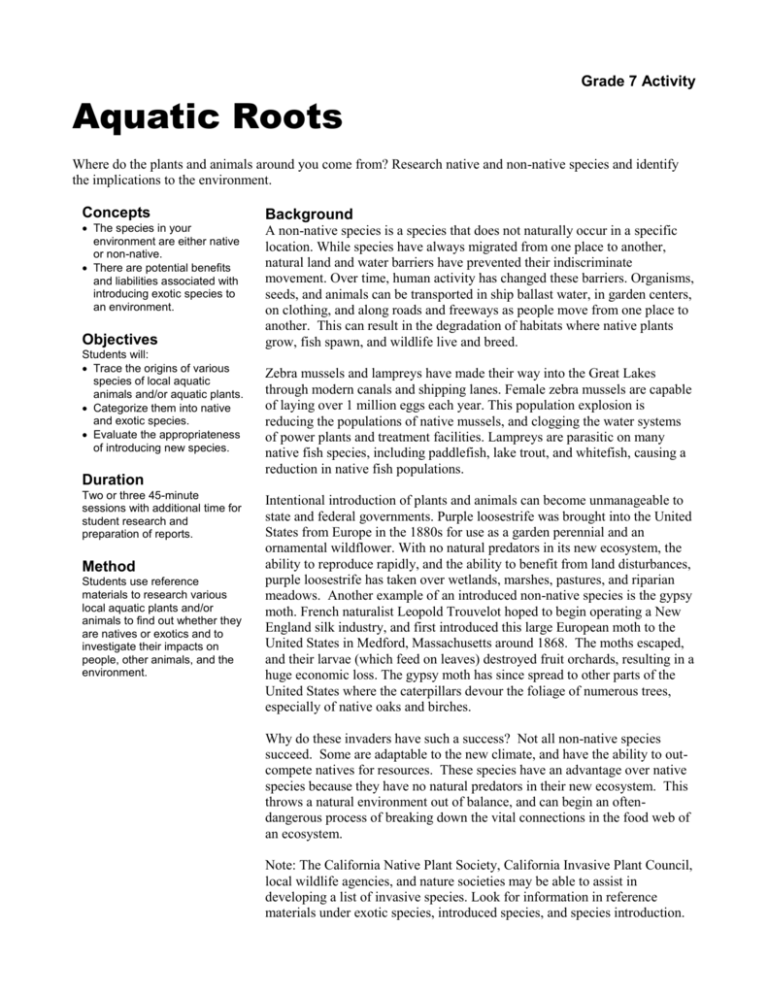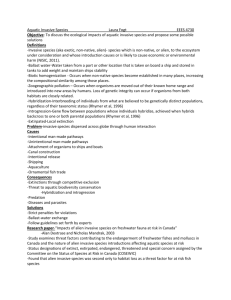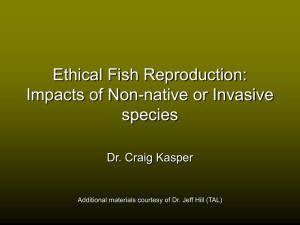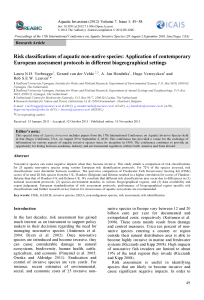aquaticroots - Friends of Ballona Wetlands
advertisement

Grade 7 Activity Aquatic Roots Where do the plants and animals around you come from? Research native and non-native species and identify the implications to the environment. Concepts The species in your environment are either native or non-native. There are potential benefits and liabilities associated with introducing exotic species to an environment. Objectives Students will: Trace the origins of various species of local aquatic animals and/or aquatic plants. Categorize them into native and exotic species. Evaluate the appropriateness of introducing new species. Duration Two or three 45-minute sessions with additional time for student research and preparation of reports. Method Students use reference materials to research various local aquatic plants and/or animals to find out whether they are natives or exotics and to investigate their impacts on people, other animals, and the environment. Background A non-native species is a species that does not naturally occur in a specific location. While species have always migrated from one place to another, natural land and water barriers have prevented their indiscriminate movement. Over time, human activity has changed these barriers. Organisms, seeds, and animals can be transported in ship ballast water, in garden centers, on clothing, and along roads and freeways as people move from one place to another. This can result in the degradation of habitats where native plants grow, fish spawn, and wildlife live and breed. Zebra mussels and lampreys have made their way into the Great Lakes through modern canals and shipping lanes. Female zebra mussels are capable of laying over 1 million eggs each year. This population explosion is reducing the populations of native mussels, and clogging the water systems of power plants and treatment facilities. Lampreys are parasitic on many native fish species, including paddlefish, lake trout, and whitefish, causing a reduction in native fish populations. Intentional introduction of plants and animals can become unmanageable to state and federal governments. Purple loosestrife was brought into the United States from Europe in the 1880s for use as a garden perennial and an ornamental wildflower. With no natural predators in its new ecosystem, the ability to reproduce rapidly, and the ability to benefit from land disturbances, purple loosestrife has taken over wetlands, marshes, pastures, and riparian meadows. Another example of an introduced non-native species is the gypsy moth. French naturalist Leopold Trouvelot hoped to begin operating a New England silk industry, and first introduced this large European moth to the United States in Medford, Massachusetts around 1868. The moths escaped, and their larvae (which feed on leaves) destroyed fruit orchards, resulting in a huge economic loss. The gypsy moth has since spread to other parts of the United States where the caterpillars devour the foliage of numerous trees, especially of native oaks and birches. Why do these invaders have such a success? Not all non-native species succeed. Some are adaptable to the new climate, and have the ability to outcompete natives for resources. These species have an advantage over native species because they have no natural predators in their new ecosystem. This throws a natural environment out of balance, and can begin an oftendangerous process of breaking down the vital connections in the food web of an ecosystem. Note: The California Native Plant Society, California Invasive Plant Council, local wildlife agencies, and nature societies may be able to assist in developing a list of invasive species. Look for information in reference materials under exotic species, introduced species, and species introduction. Materials Activity 1. A world map 2. Yarn 3. Tacks 4. Paper 5. Reference materials 6. List of non-native plants and animals 1. Provide the students with a list of local native and non-native species. Ask them to predict which of the plants and animals are “native” and which are introduced or “non-native.” Establish clear working definitions of “native” and “non-native.” A native species occurs naturally in an area. Any plant or animal not naturally occurring in the ecosystems of the United States becomes non-native once it is introduced. Preparation 2. If the students’ predictions were not entirely accurate, identify the nonnatives for the students on the provided list. Collect materials and photocopy the list of native and non-native species for each student. 3. Next, ask each student or small group of students to research one species known to be “introduced” as a non-native to the area or state. Within the class, ideally a variety of introduced species will be studied, including aquatic species. Each student should prepare a written and report. Include information in the research concerning the origins of the plant or animal and its impacts in the area. Has the introduction created more benefits or liabilities for the ecosystem? The students could create a two-column list of benefits and liabilities. In addition to simply listing benefits and liabilities, they could assess the importance of each item in the columns. Benefits and liabilities – positive and negative effects – may not have equal value. Some introductions may seem to have both positive and negative effects. This will be reflected when the students list items under both the “benefits” and “liabilities” columns. Some effects will be unknown so students might also generate a list of unknown effects or questions. 4. Ask each student or group of students to report to the class. Following the reports, encourage discussion and debate. Ask the students to identify and discuss potential benefits and liabilities involved. Then ask the students to evaluate the appropriateness of each of the introductions in their personal judgment, identifying and describing their criteria. They might also consider the potential introduction of a species that is common somewhere else, but is not yet in their area. 5. Using a world map, have the students connect their location with the original location of non-native species. Stretch a strand of yarn from their location to the site of origin of each organism and place a tag on the yarn with the name of the plant or animal. 6. Preventing “accidental” introductions is also important. Develop a list of ways these introductions can occur and ways to help assure that they don’t happen. Discuss the importance of laws and regulations that prevent, control, and/or allow introductions of species. Extensions 1. Investigate and compare local, state, and federal laws pertaining to introducing exotics into aquatic environments. 2. Investigate how humans have reintroduced some wildlife species into their original habitat where the species had previously become extinct. Have them distinguish some differences and similarities between re-introductions and non-native species. Evaluation 1. Identify three native aquatic plants and animals in your area. Identify three exotic aquatic plants and animals that exist in your area. 2. Give four reasons why an aquatic plant or animal might be introduced in an area. Are these reasons appropriate? Why or why not? 3. A local organization has proposed that a new fish be introduced into a state’s rivers or lakes. List at least five questions that could be answered about the fish and its impact on the state’s watercourses before the proposal is approved or rejected. Additional Resources United States Geological Survey Invasive Species: http://biology.usgs.gov/invasive/Science%20Centers/WesternEcologicalWERC.htm San Francisco Chronicle. Battle over an island: http://www.sfgate.com/cgi-bin/article.cgi?file=/chronicle/archive/2006/06/08/SPG3GJACPF1.DTL Native and Introduced Plants of Southern California: www.tchester.org/plants/index.html “The Status of rare, threatened and endangered plants and animals of California 2000-2004.” California Department of Fish and Game, Habitat Conservation Planning Branch Publication. Adapted by Friends of Ballona Wetlands from: “Aquatic Roots” (p 163-165) Project WILD Aquatic K-12 Curriculum and Activity Guide. © 2000 by the Council for Environmental Education









